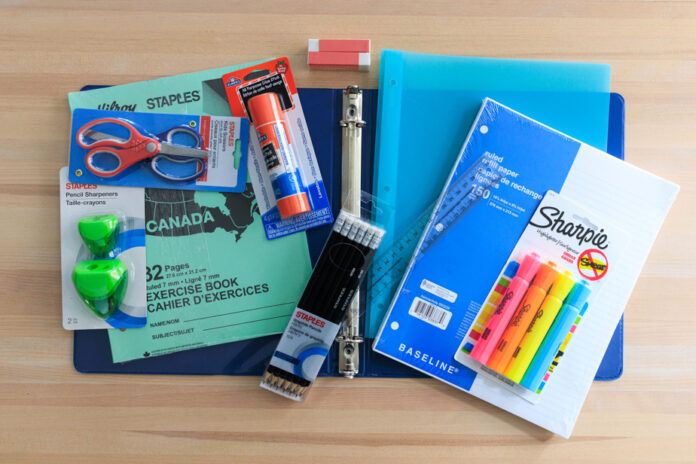Subject to inflation, school supplies are expensive for parents. A trip to five stores to buy the same 11 basic items for a child attending elementary school demonstrates the wide variation in prices: the same school bag costs $0.99 here and $12.29 there.
“We can go from a correct price to its quadruple for several items on the list of school supplies,” says Olga Cherezova, budget advisor at the Cooperative Association of Family Economics (ACEF) of the east of Montreal. It’s important to shop around and compare, so you can watch the prices and get an idea of how much it really costs. »
The rigid plastic satchel (one inch thick) is a staggering example of the price gap: for an identical product, it is advertised at $0.99 at Jean Coutu and $12.29 at Staples. Another striking example? The same pack of four Sharpie-branded highlighters is sold at a random price of $1.98 at Walmart and $4.98 at the neighborhood stationery store (in this case, Papeterie Léo, in Montreal’s east end). .
For the number of items, eleven in all, purchased at five different locations, the bill goes from $21.66 (at Dollarama) to double, or $43.20 (at Staples).
The catch? This changes from week to week, store to store – and the fluctuation can be big.
“This week, such an item may be cheaper in pharmacies and the following week, it is sold at a lower price in a supermarket,” said Ms. Cherezova. You have to be informed and know what is, exactly, the “right” price. »
Mother of five children and mother-in-law of three children, aged 6 to 15, Andrée-Ann Pinard applies herself from June, at the end of the school year, to prepare for the next school year. “I start by checking the social networks of the schools my children attend to take a look at lost objects and identify if certain things belong to them,” she says. This saves me from unnecessary future expenses. »
Helped by her children, the 41-year-old manager then empties the school bags and sorts the materials: everything that can be reused is kept. “We take inventory,” she notes, “and I start my shopping early enough in the summer to run the specials at several stores. I take this opportunity to stock up. »
According to the organization Regroupement Parte, the total amount paid for school supplies for an elementary child in Greater Montreal is on average $130, or 30% more than two years ago. Mrs. Pinard, for her part, estimates that she only has “a third of the list to buy” for each of her children; it still costs him $110 per child.
“I try to be organized,” she says, “and it’s still a fun time for me and for the kids. »
That’s not the case for everyone: for many families, who must take into account skyrocketing rent and food prices, back-to-school shopping is the straw that breaks the camel’s back. “This is a time of great financial concern for families,” says Johanne Le Blanc, budget advisor at Option consommateurs. It’s already difficult to make ends meet. »
His best advice is to prepare your budget well to meet these expenses. “They’re predictable,” she says, “so I suggest picking up some money in September for the next school year.” »
Mrs. Pinard has developed a surefire trick for saving: she makes group purchases with friends who have children the same age as hers. This allows him to buy large quantities at lower costs.
“I often buy a lot of colored pencils, lead pencils, markers, erasers, glue sticks and writing books,” she says. I go with a friend to do all the shopping and we divide the items as well as the amounts of the invoices. We managed to save a lot of money. »
Jessica Laflamme, owner of the company Do more with less, which offers home economics workshops and planning tools, points out how the family counters are invaluable resources.
“You have to deconstruct the image that it is associated with poverty,” explains the mother of three children aged 7, 9 and 12. Organizations like Centraide, Renaissance or family crossroads hold real treasures! These are bazaars where you can find everything. »
She points out that there are also items related to lunches – dishes and thermoses, for example. She also likes to stock up on snacks (granola bars, crackers, etc.) when they are on sale at the grocery store.
“I think you have to use your money consciously, she slips, and at the same time, we inform and educate our children. There is a reflection to do beforehand: what is necessary, what is mandatory and what is superfluous? »
Ms. Le Blanc of Option consommateurs agrees. According to her, regardless of our income and our budget, we must learn to make choices. “Saying ‘no’ to the little extras kids ask for is starting their financial education. The trick is to go beyond the list. »
Because after the bill for school supplies, there is that of the daycare service to come, just like that of extracurricular activities, the cafeteria or the uniform…
“Use your common sense, concludes Olga Cherezova, of the ACEF of the east of Montreal. If a brand is more expensive, even if it is listed on the school list, there is a substitute that does the trick. If the budget doesn’t allow it, why pay more? »
Here are tips and advice from the experts.
Sources: Olga Cherezova, ACEF de l’est de Montréal, Johanne Le Blanc, Option consommateurs, Jessica Laflamme, Doing More with Less, and Andrée-Ann Pinard















